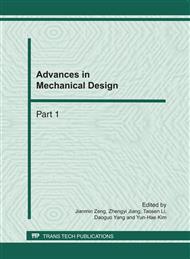[1]
D. Grandy , P. Koshy and F. Klocke. Pneumatic non-contact roughness assessment of moving surfaces. C.I.R. P Annals – Manufacturing Technology, Vol. 58, (2009), pp.515-518.
DOI: 10.1016/j.cirp.2009.03.121
Google Scholar
[2]
Y. Sahin, and A.R. Motorcu,. Surface roughness model in machining hardened steel with cubic boron nitride cutting tool. International Journal of Refractory Metals & Hard Materials, Vol. 26, (2008), pp.84-90.
DOI: 10.1016/j.ijrmhm.2007.02.005
Google Scholar
[3]
M. C. Cakir , C. Ensarioglu and I. Demirayak. Mathematical models of surface roughness for evaluating the effects cutting parameters and coating materials. Journal of materials processing technology, Vol. 209, (2009), pp.102-109.
DOI: 10.1016/j.jmatprotec.2008.01.050
Google Scholar
[4]
J. P. Davim , V.N. Gaitonde and S.R. Karnik. Investigations into the effect of cutting conditions on surface roughness in turning of free machining steel by ANN models. Journal of materials processing technology, Vol. 205, (2008), pp.16-23.
DOI: 10.1016/j.jmatprotec.2007.11.082
Google Scholar
[5]
S.K. Choudhury and K.K. Kishore. Tool wear measurement in turning using force ratio. International Journal of Machine Tool & Manufacture, Vol. 40, (2000), pp.899-909.
DOI: 10.1016/s0890-6955(99)00088-7
Google Scholar
[6]
C.X. Feng and X.F. Wang. Surface roughness predictive modeling: neural networks versus regression. IIE Transactions, Vol. 35-1, (2003), pp.11-27.
DOI: 10.1080/07408170304433
Google Scholar
[7]
M. Shiraishi. In-Process Measurement of Surface Roughness in Turning by Laser Beams. Journal of Engineering for Industry, Vol. 103, (1981), pp.203-209.
DOI: 10.1115/1.3184477
Google Scholar
[8]
J. Nara. Two dimensional Representation of Surface Roughness. Annals of the C.I.R. P, Vol. 1, (1969), pp.485-493.
Google Scholar
[9]
M.G. Ignatov , A.E. Perminov and E. Yu. Prokof'ev. Influence of the vertical cutting force on the surface precision and roughness in opposed milling. Russian Engineering Reserch, Vol. 28-9, (2008), pp.864-865.
DOI: 10.3103/s1068798x08090074
Google Scholar
[10]
D.I. Lalwani , N.K. Mehta and P.K. Jain. Experimental investigation of cutting parameters influence on cutting forces and surface roughness in finish hard turning of MDN250 steel. Journal of materials processing technology, Vol. 206, (2008).
DOI: 10.1016/j.jmatprotec.2007.12.018
Google Scholar
[11]
T. Moriwaki, T. Shibasaka, and T. Somkiat. Development of in-process tool wear monitoring system for CNC turning. International Journal of Japan Society of Mechanical Engineers, Series C Vol. 47-3, (2004), pp.933-938.
DOI: 10.1299/jsmec.47.933
Google Scholar
[12]
J.H. Lee, D.E. Kim and S.J. Lee. Statistical analysis of cutting force ratios for flank-wear monitoring. Journal of Materials Processing Technology, Vol. 74, (1998), pp.104-114.
DOI: 10.1016/s0924-0136(97)00256-2
Google Scholar
[13]
T. Somkiat. In-Process Investigation of Turning Process Applied with and without Cutting Fluid. Journal of Mechanical Engineering, Vol. 6, (2009), pp.85-102.
Google Scholar
[14]
J. Tlusty and G.C. Andrews. A Critical Review of Sensors for Unmanned Machining. Annals of the C.I.R. P, Vol. 32, (1983), pp.563-572.
DOI: 10.1016/s0007-8506(07)60184-x
Google Scholar
[15]
D. Patrik, G. Fredrik and J. Michael. The influence of rake angle, cutting feed and cutting depth on residual stresses in hard turning. Journal of Materials Processing Technology. Vol. 147, (2004), pp.181-184.
DOI: 10.1016/j.jmatprotec.2003.12.014
Google Scholar
[16]
S. Jeelani, S. Biswas and R. Natarajan. Effect of cutting speed and tool rake angle on residual stress distribution in machining 2024-T351 aluminium alloy, unlubricated conditions. Journal of Materials Science, Vol. 21, (1986), pp.2705-2710.
DOI: 10.1007/bf00551476
Google Scholar


